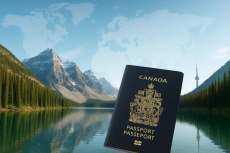Blog • Published on:November 24, 2025 | Updated on:November 24, 2025 • 7 Min
Where Can You Travel Visa-Free with a Chinese Passport in 2025?
The Chinese passport offers expanding travel flexibility in 2025.
Thanks to a growing mix of permanent visa-free agreements, newly introduced 30-day waivers, and simplified entry pathways, Chinese travellers can now access more destinations across Asia, Europe, the Middle East, Latin America, and the Pacific.
For anyone planning a trip, understanding the difference between visa-free, visa-on-arrival, and eVisa entry makes travel smoother and helps avoid unnecessary embassy steps.
In this guide, you’ll find a clean breakdown of where Chinese citizens can go in 2025, and how each entry category works.
What Should You Know About China’s Passport Mobility in 2025?
China’s mobility is shaped by:
- Permanent visa-free agreements
- Temporary exemptions valid until 31 December 2026
- Regional travel partnerships, especially in Asia
- Bilateral agreements that open short-term travel channels
- Business mobility tools like the APEC Business Travel Card
This mix means Chinese citizens enjoy more short-stay access than ever, even though many destinations still require an embassy-issued visa for longer or work-related stays.
Which Countries Offer Visa-Free Entry to Chinese Citizens in 2025?
Chinese citizens can enter a wide range of destinations without a visa in 2025.
These fall into two categories:
- Permanent visa-free agreements (stable, long-term, renewed automatically)
- Temporary visa exemptions valid until 31 December 2026 (newly expanded program)
Below is the complete, verified breakdown.
Permanent Visa-Free Countries and Territories
These destinations allow entry with no prior application and remain consistently available year after year.
Temporary Visa-Free Countries (Until 31 December 2026)
These countries allow 30-day visa-free entry for Chinese passport holders until the end of 2026.
Key Takeaways
- China now has one of the fastest-growing visa-free networks in the world.
- The 2026 temporary program dramatically increases access to Europe, Oceania, and the Gulf.
- Visa-free stays are for tourism, business, family visits, not work or long-term residence.
Which Countries Offer Visa-on-Arrival for Chinese Citizens in 2025?
Visa-on-Arrival (VOA) gives Chinese travellers the ability to obtain a visa directly at the airport or land border without applying in advance.
This is practical for spontaneous travel, regional trips, and destinations where embassies are limited.
China’s VOA access is moderate but spans Asia, Africa, the Middle East, the Pacific, and parts of Latin America.
What Documents Do Chinese Travellers Need for VOA?
Most destinations request:
- Passport valid 6+ months
- Return or onward flight ticket
- Proof of accommodation (hotel or host address)
- Sufficient funds (cash or card)
- Completed arrival form
- Visa fee (cash USD is safest)
Some African or Middle Eastern countries may also require:
- Yellow fever vaccination certificate
- Business invitation letters (if applicable)
- On-the-spot fingerprints or photo capture
What Should You Expect During VOA Processing?
Typical VOA steps:
- Queue at the visa counter after landing
- Fill in visa/arrival form
- Submit passport + documents
- Pay visa fee
- Receive visa sticker or entry stamp
Standard processing time: 5–20 minutes, longer at land borders.
Which Countries Require an eVisa for Chinese Citizens in 2025?
An eVisa allows Chinese travellers to apply online before departure, avoiding embassy visits while still meeting entry requirements.
Processing times generally range from 24 hours to 7 days, depending on the country.
China now has one of the world’s widest eVisa networks, particularly across Africa, Central Asia, and the Middle East.
Processing Times and Validity Overview
Typical Processing Speeds
- Fast (24–72 hours): UAE, Kenya eTA, Sri Lanka ETA, Turkey (not for Chinese)
- Standard (3–7 days): India, Vietnam, Suriname, PNG
- Extended (7–10 days): Libya, Syria, South Sudan
Common Validity Periods
- 30 days: India, Iran, Nepal, Sri Lanka, Cambodia
- 60–90 days: Tanzania, Madagascar, Malawi, Uganda
- 1 year or multi-entry: UAE, Saudi Arabia, India
Which Destinations Require a Traditional Visa for Chinese Citizens in 2025?
Despite China’s expanding visa-free and eVisa access, a large number of destinations still require Chinese citizens to obtain a traditional visa before traveling.
These countries usually enforce embassy-issued visas due to:
- security and migration controls
- reciprocity rules
- regional immigration policies
- long-stay or multi-purpose entry requirements
A traditional visa typically requires:
- passport valid for 6+ months
- application form + biometric photo
- bank statements
- travel itinerary
- accommodation proof
- sometimes: invitation letters, employment documents, in-person interviews
Processing time: 5–15 business days (longer for the US, UK, Schengen).
How Do Asian Regional Travel Agreements Shape China’s Mobility?
China’s travel landscape in Asia is shaped not only by visa-free or visa-required rules but also by regional partnerships, tourism cooperation programs, and bilateral entry arrangements.
These frameworks don’t always grant full visa-free access, but they make travel easier, especially for group tours, business travellers, and visitors using approved travel channels.
China’s strongest mobility advantages in Asia come from:
- ASEAN tourism cooperation and short-stay facilitation
- Belt and Road Initiative (BRI) partnerships that expand entry flexibility
- Bilateral short-stay agreements with key regional governments
Below is a clear breakdown of how these mechanisms work in 2025.
Do ASEAN Member States Offer Special Access to Chinese Travellers?
While China is not an ASEAN member, it maintains one of the world’s closest tourism and business networks with Southeast Asia.
This results in:
- predictable short-stay rules
- visa-free entry in several ASEAN countries
- lenient application options (VOA/eVisa) in others
- fast-track processing for group tours
What Should Chinese Travellers Keep in Mind in 2025?
China’s global mobility is expanding, but each destination still has its own rules, limits, and documentation checks.
To avoid delays at immigration, here are the most important points every Chinese traveller should consider before planning a trip in 2025.
Stay Updated on Each Country’s Entry Rules
Visa policies change often, sometimes with very little notice.
Temporary programs (such as those valid until 2026) may expire or be adjusted.
Before travelling, always recheck:
- Whether the visa-free policy is still active
- Maximum stay allowed
- Whether business visits are permitted
- If a digital pre-arrival form (ETA/eTA) is required
- Any conditions for ordinary vs. diplomatic passports
The safest sources include IATA Travel Centre and the destination country’s immigration website.
Prepare Basic Documents Even for Visa-Free Destinations
Many visa-free and VOA destinations still perform additional checks at the border.
Immigration officers may ask for:
- A passport valid for at least 6 months
- Return or onward flight booking
- Hotel reservations or local address
- Proof of sufficient funds
- Travel insurance (recommended)
Carrying these in both digital and printed form helps avoid issues at arrival.
Consider an eVisa When both eVisa and VOA Are Available
In many countries, Chinese travellers can choose between VOA and eVisa.
An eVisa is usually the safer option because:
- You receive approval before departure
- It avoids long queues at the border
- It reduces the chance of rejection due to missing documents
- Some airports have limited VOA counters or slow processing
VOA is convenient but less predictable during peak travel seasons.
Know That Visa-Free Access Does Not Allow Long-Term Stays
Short-stay access (30–90 days) usually covers:
- Tourism
- Family visits
- Short business trips
- Transit
It does not permit:
- Employment
- Study programs
- Residency or relocation
- Business operations requiring licensing
Travellers planning longer stays should apply for the correct long-term visa.
Keep All Travel Documents Easily Accessible
Chinese travellers should carry both electronic and physical backups of:
- Passport bio page
- Flight bookings
- Hotel confirmations
- eVisa / ETA approvals
- Itinerary
- Emergency contact details
Some countries, especially in Africa, the Middle East, and Oceania, may request printed confirmation even when a digital version exists.
FAQs About Chinese Passport Travel in 2025
Which regions offer the easiest travel options for Chinese nationals?
The most accessible regions for Chinese travellers include:
- Southeast Asia (Thailand, Malaysia, Singapore, Brunei)
- Central Asia (Kazakhstan, Uzbekistan)
- Middle East (UAE, Qatar, Bahrain)
- Pacific Islands (Fiji, Samoa, Tonga)
These regions offer a mix of visa-free, VOA, and streamlined eVisa entry.
Do Chinese citizens need a visa for Europe or the United States?
Yes. Chinese travellers must apply for a Schengen visa to visit Europe and require a visa for the UK, United States, Canada, Australia, and New Zealand.
Some European and Gulf countries are currently visa-free under temporary programs valid until 2026.
Is an eVisa better than Visa-on-Arrival for Chinese travellers?
Generally, yes.
An eVisa is more reliable because it provides:
- Pre-approved entry
- Faster airport processing
- Lower risk of rejection
- Less uncertainty at the border
VOA is convenient but can result in delays or stricter checks.
What documents should Chinese travellers bring, even for visa-free trips?
Even in visa-free destinations, travellers should carry:
- Passport valid for 6+ months
- Return or onward ticket
- Hotel booking or local address
- Proof of funds
- Printed eVisa/ETA (if applicable)
- Travel insurance (recommended)
Immigration officers may request these at the border.
References
National Immigration Administration of China – Entry and Exit Policies for Chinese Citizens. Referred from: https://www.nia.gov.cn
IATA Travel Centre – Global Visa, Health, and Travel Requirements Database. Referred from: https://www.iatatravelcentre.com
Wikipedia – Visa Policy of China; Visa Requirements for Chinese Citizens. Referred from: https://www.wikipedia.org
Ministry of Foreign Affairs of the People’s Republic of China – Consular Services and Bilateral Agreements. Referred from: https://www.fmprc.gov.cn
APEC Business Mobility Group – APEC Business Travel Card (ABTC) Framework and Mobility Guidelines. Referred from: https://www.apec.org
Written By

Laura Weber
Laura Weber is a legal expert in international tax planning and citizenship by investment. With over a decade of experience, Laura helps individuals and families navigate complex legal frameworks to secure dual citizenship and global residency options, particularly in the Caribbean and Europe.
Related Articles









Recently Published









Book a free consultation


